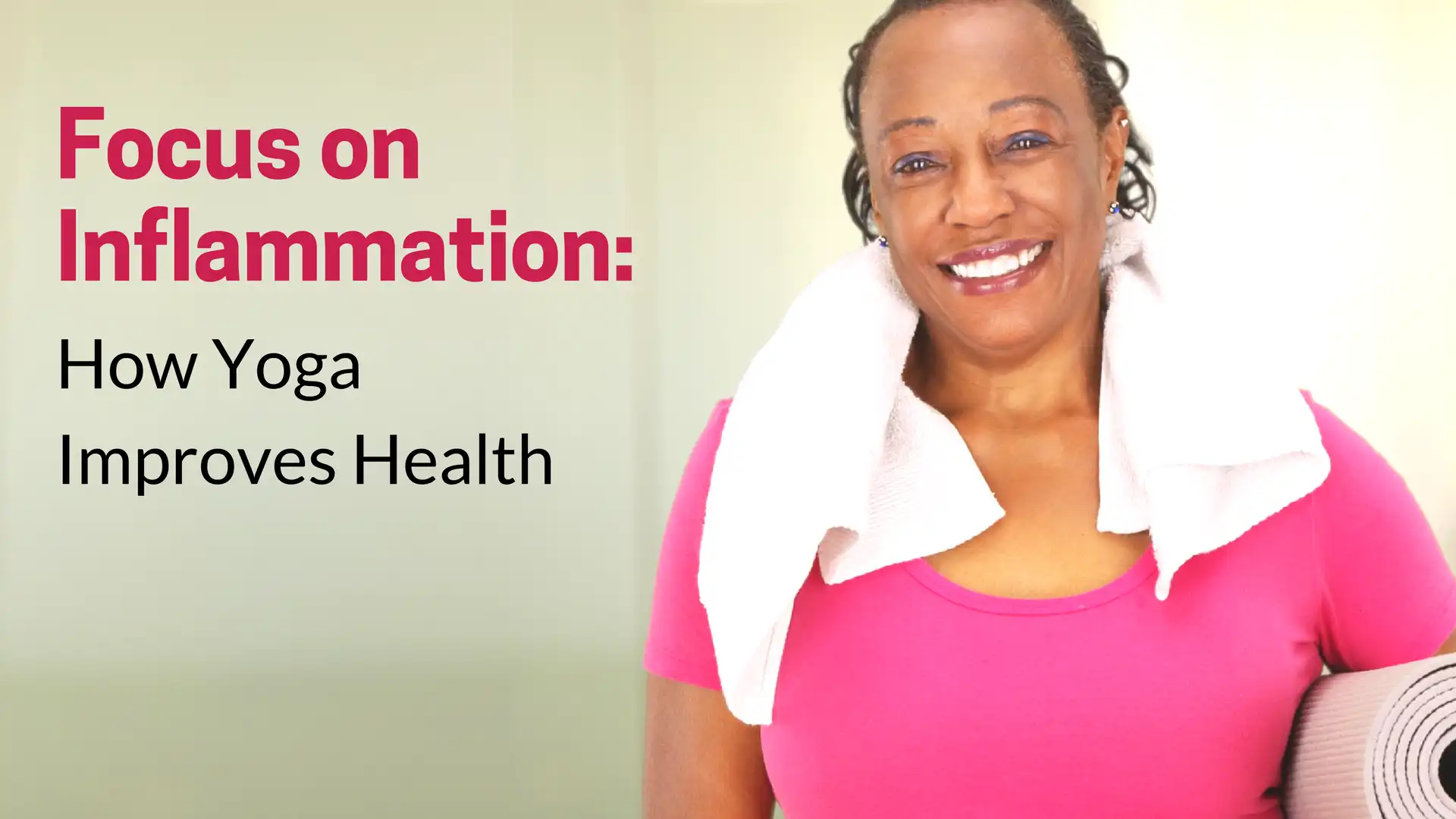How Yoga Improves Health: Focus on Chronic Inflammation

Inflammation is part of the body’s defense response. It involves the clearance of toxic pathogens, damaged cells, or harmful irritants from the body.
Inflammation has a high beneficial value. For example, if you develop a viral infection or if your back sustains a severe blow, inflammation sets in to care and protect the injured tissue and initiate a healing response.
What are the Signs of Inflammation?

The classical signs of inflammation are pain, heat, redness, and fluid accumulation (swelling), and reflect the activation of the body’s defensive strategies that ward off the damage and heal the injured area. The defensive strategies are carried out by leukocytes, macrophages, dendritic cells, mast cells, bradykinin, histamine, interleukins, and TNF, among others.
What are the Signs of Chronic Inflammation?
In a perfect setting, the inflammatory process occurs just as it should, releasing defense/pro-inflammatory molecules when needed and then turning them off when the threat has been sufficiently addressed.
Chronic inflammation, on the other hand, is characterized by an aberrant, out-of-control defense response and is akin to a constant slow-burning fire. In chronic inflammation, the defense/pro-inflammatory molecules continue to be present in the body even when they are not needed, and the body operates as if it is constantly under attack. Thus, chronic inflammation continuously draws on your body’s energy and resources, which can result in bodily damage with time. Furthermore, as the system goes out of control, it self-perpetuates and triggers severe disease conditions, including atherosclerosis (inflammation in blood vessels), diabetes (inflammation in pancreatic tissue), arthritis (inflammation in bones and joints), celiac disease (inflammation in the digestive system), fibromyalgia, neuralgia (inflammation in limbs, muscles, and nerves), and ankylosing spondylitis (inflammation in the spinal region), among others.
In addition to the factors that influence inflammation that I outlined in my previous post, today I’m updating that list to include:
Obesity
This is now considered a heightened state of chronic inflammation because of the elevated plasma levels of several pro-inflammatory markers. It is believed that fat cells (adipocytes) themselves trigger the release of a number of these markers in the bloodstream.
Physical Activity
People who are physically very active have lower levels of inflammatory biomarkers than their sedentary counterparts, so physical fitness is inversely associated with inflammation.
Emotions
Emotional disorders, including anxiety and depression, can trigger inflammation and elevate the levels of pro-inflammatory molecules.
Stress
Chronic stress can directly provoke increases in proinflammatory cytokines.
Furthermore, inflammation is now regarded as a risk factor for most cancers as well because of the recent evidence that inflammation influences cancer cells to grow, survive, and proliferate. Scientists believe that cancer treatment procedures trigger the inflammatory process that fails to turn off. In addition to the weakness and pain from the cancer therapy procedures, cancer patients now suffer from inflammation that draws on their body’s resources, resulting in chronic fatigue. It’s as though the body’s defense system fails to distinguish itself, thus making the body vulnerable to attacks from its own cellular system.
How Yoga Can Help with Inflammation

Yoga can help with all these factors. It can help in controlling obesity by making correct choices of our eating habits and controlling stress and emotions. In a landmark study in the Journal of Clinical Oncology, researchers showed that cancer survivors who had a regular yoga practice (a) reported less fatigue and higher levels of vitality, (b) showed reduced levels of several pro-inflammatory molecules in the body, (c) reported less pain and less inflamed joints, and (d) demonstrated significantly improved sleep. This study not only offered biological evidence of the benefits of yoga, but it also substantiated people’s own reports of their improvement.
Yoga and yoga-related practices, including meditation, affect cellular processes at many levels that result in immense health benefits. While most of the health benefits may not appear immediately, all the benefits of yoga may become evident with a sustained and regular practice. So the next time you visit your doctor and are told that you have an inflammatory condition, think of yogic management practices.
Reprinted with permission from yogaforhealthyaging.blogspot.com.
Another article on inflammation from YogaUOnline – How Yoga Helps You Stay Young Longer: Study Shows Stress Relief Helps Reduce Inflammation.
Ram Rao, Ph.D. With a doctorate in Neuroscience, Ram is a Research Associate Professor at the Buck Institute for Research on Aging. He focuses on various aspects of age-associated neurodegenerative diseases with emphasis on Alzheimer’s disease. In addition, Ram completed academic training at the California College of Ayurveda (CCA) and received his certification as a Clinical Ayurvedic Specialist. He is a faculty member of the California College of Ayurveda and teaches at their Nevada City location. Ram is also a dedicated Hatha yoga practitioner and a registered yoga teacher at Yoga Alliance USA. In his spare time, he offers consultations on YAMP techniques (Yoga, Ayurveda, Meditation, & Pranayama). Ram has published several articles in major Yoga/Ayurveda magazines and has been a featured speaker in several national and international meetings and symposia. He is a member of the National Ayurvedic Medical Association (NAMA) and is on the Research Board of the Association of Ayurvedic Professionals of North America (AAPNA).




